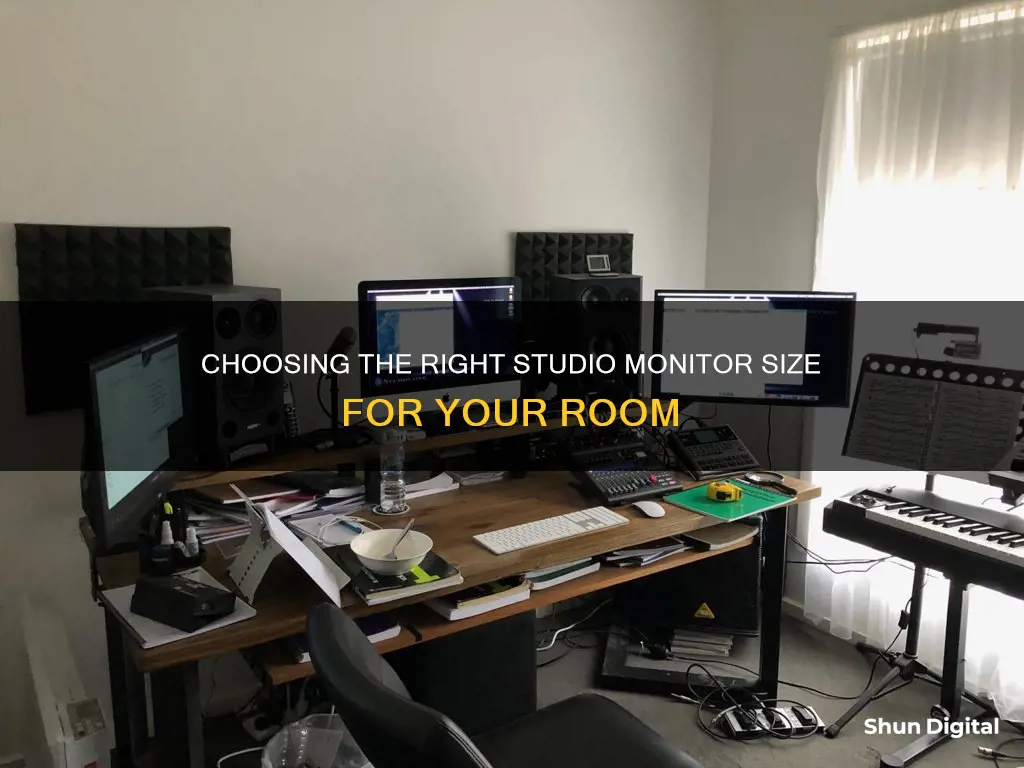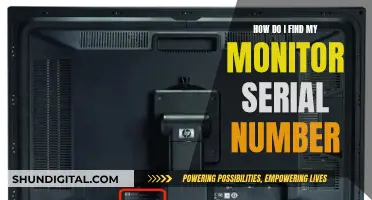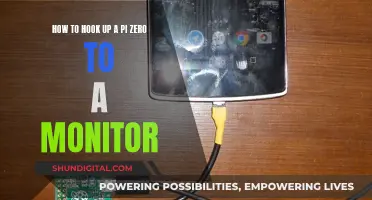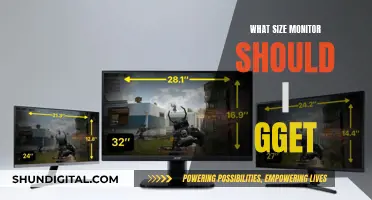
When it comes to studio monitors, size does matter. The size of your room and the style of music you produce will determine the size of your studio monitor. For instance, if you are an EDM producer, you will require a studio monitor that can deliver a better low-frequency response, so a bigger driver size would be more suitable. Conversely, smaller speakers may offer better midrange and high-frequency response due to their ability to reproduce these frequencies more accurately. As a general rule, the smaller the room, the smaller the studio monitor you should opt for.
| Characteristics | Values |
|---|---|
| Studio Monitor Size | 3-8 inches |
| Room Size | Small to Large |
| Music Genre | Dance, Hip Hop, Singer/Guitarist |
| Acoustic Treatment | Acoustic Panels, Bass Traps, Soundproofing |
| Monitor Type | Passive, Powered, Active |
| Amplifier Configuration | Single-Amp, Bi-Amp, Tri-Amp |
| Wattage | 50-75 watts (Small Rooms), 100+ watts (Large Rooms) |
| Budget | $200-$400 (Beginner), $400-$1,000 (Intermediate), $1,000+ (Professional) |
What You'll Learn

Room acoustics and speaker placement
Choose the Right Room and Treat Acoustics:
- While not always possible, selecting a room with desirable dimensions and characteristics is a good starting point. Avoid rooms with equal dimensions (e.g., cube-shaped) as these tend to cause significant peaks in certain frequencies, resulting in some frequencies sounding much louder than others.
- Consider the room's purpose: will it be solely for mixing, or will it also accommodate instruments and other equipment? This will influence the available space and surface treatments.
- Treat the room's acoustics by addressing reflections, absorption, and diffusion. Use acoustic treatment products like bass traps, acoustic panels, and diffusers to minimise unwanted sound reflections and create a more controlled listening environment. Focus on the first reflection points, especially side walls and the area behind the monitors.
- Carpeted floors and absorbent furniture can help tame bass problems and reduce reverberation. Avoid excessive wall treatment, especially with carpet or foam, as it can lead to a boxy-sounding room.
Speaker Placement and Geometry:
- Symmetry is essential. Place your monitors symmetrically, forming an equilateral triangle with your head as one of the vertices. This ensures a natural stereo "sweet spot."
- The distance between the left and right speakers and the distance from each speaker to the back of your head should be equal.
- Ensure the monitors are pointed directly at your head or slightly behind it. The high frequencies are more directional, so adjust the angle to hear these accurately.
- Position the tweeters at ear height when seated, typically about 47-55 inches (120-140 cm) from the floor. If necessary, tilt the speakers slightly downwards while ensuring they remain stable.
- If possible, avoid placing the speakers against the wall. The recommended distance varies depending on the source, ranging from at least 5-10 cm to at least 43 inches (110 cm) away from the wall.
- If your speakers have rear ports, maintain a distance from the wall that is at least equal to the port diameter.
- Avoid placing speakers near side walls or corners as it can cause uneven bass response. If this is unavoidable, use the quarter-space EQ setting on the speakers to mitigate bass build-up.
- Isolate the speakers from the surface they are resting on (desk, stands, etc.) to minimise vibration and resonance. Use speaker isolation pads or stands with vibration reduction features.
Fine-Tuning and Additional Considerations:
- Experiment with different speaker placements and angles while playing music to find positions that produce a more even sound response.
- Nearfield monitoring, where you sit closer to the monitors (around one metre or less), can help reduce the impact of room reflections and imperfections.
- Use a subwoofer to extend the low-frequency response. Place it where the bass sounds best in the room, typically marked by a crossover or cutoff frequency setting on the subwoofer.
- If you experience localisation of the subwoofer, try lowering the crossover point or using two subwoofers placed below the main speakers.
- Refer to commercial recordings and test songs mixed without EQ to gain perspective and identify any problems in your monitoring environment.
Signs Your LCD Monitor is Failing
You may want to see also

Speaker size and distance from walls
The placement of studio monitors in a room is crucial to achieving an accurate frequency response and a solid stereo image. The ideal setup is to have the listening position and the two monitors form an equilateral triangle, with the monitors pointing directly at the listener's ears or slightly behind them. The height of the monitors should be adjusted so that the tweeters are at the listener's ear level when seated, typically about 47-55 inches (120-140 cm) from the floor.
When evaluating the distance between monitors and walls, it is important to maintain a minimum distance of 20-30 cm (8-12 inches) to reduce sound waves reflecting back to the listening position. The maximum distance should be between 60 and 90 cm. Additionally, the monitors should be placed at different distances from the side and back walls to avoid creating corners in the listening position.
If the studio monitors have rear ports, it is recommended to keep them away from the wall by at least the same distance as the port diameter, usually about 5 to 10 cm. Placing monitors too close to the front wall can exaggerate the bass response by up to 6 dB. On the other hand, placing them too far from the wall can cause uneven bass response due to low-frequency reflections. As a general guideline, monitors should be placed either almost against the front wall or at least 43 inches (110 cm) away.
Speaker stands can be used to optimise the geometry and create the optimum triangle setup. Isolation pads can also be used to decouple the speakers from their stands or the desk, reducing vibrations and resonances.
Routing Audio: S4 MK3 Studio Monitor Setup Guide
You may want to see also

Bass requirements of music genre
The size of studio monitors depends on the room size and the music style. For instance, if you are an EDM producer, you will require a better low-frequency response, and therefore, a bigger driver size would be more suitable. This is because larger speakers can move more air, which is necessary for reproducing lower-frequency sounds.
Now, let's explore the bass requirements of different music genres:
Electronic Dance Music (EDM)
EDM, which includes genres such as house, trance, and dubstep, often features a prominent bass sound. The bass sound is usually created using synthesizers and drum machines. In the context of studio monitors, EDM producers might require larger monitors to accurately reproduce the low-frequency sounds that are characteristic of this genre.
Hip-Hop
Hip-hop music, which evolved alongside EDM in the 1980s, also often emphasizes bass. Similar to EDM, hip-hop producers may benefit from larger studio monitors to accurately represent the bass-heavy elements of their music.
Rock
The bass guitar plays a crucial role in rock music, from classic rock to modern alternative. In a studio context, rock musicians might focus on achieving a clear and precise representation of the bass guitar in their mixes, which can be achieved through appropriate monitor sizing and room treatment.
Jazz
Jazz bassists are known for their technical skills and improvisational abilities. Jazz music often features complex bass lines and walking bass, so jazz musicians might require studio monitors that accurately reproduce the full range of frequencies, including the low end.
Funk
Funk music is all about rhythm, groove, and syncopation, with funky bass lines that are often created using techniques like slap and pop, ghost notes, and muting. To capture the signature funky sound, funk musicians might require studio monitors that can accurately reproduce the low and midrange frequencies.
Reggae
Reggae bass lines are characterized by their simplicity and groove, often focusing on root-fifth patterns, syncopated rhythms, and melodic bass lines. Reggae musicians might not need the same low-frequency response as EDM or hip-hop producers, but accurate representation of the bass is still crucial to this genre.
Monitoring Kids' Social Media: Parenting in the Digital Age
You may want to see also

Active vs passive monitors
When it comes to studio monitors, there are two types to choose from: active and passive. Both have their own advantages and are suited to different needs and preferences.
Active Monitors
Active studio monitors have built-in amplifiers, making them simpler to use. They are easy to set up and don't require any additional equipment, so you can get started right away. The built-in amplifiers are designed specifically for the monitors, which can lead to better overall sound quality. Active monitors are also ideal if you want an easy, plug-and-play solution that is reliable and accurate. Additionally, active monitors have short internal speaker cables, reducing potential signal loss.
Passive Monitors
Passive monitors, on the other hand, require external amplifiers to function. This offers more flexibility as you can choose an amplifier that perfectly matches your monitors' power rating and impedance. Passive monitors are a good choice if you want more flexibility and are willing to put in some extra effort. They also allow for separate upgrades of the speakers and amplifier, making progression to better-quality gear more gradual and cost-effective.
Other Considerations
It's important to note that the size of your studio monitors should align with your room size and music style. For home studios, 5-inch woofers are generally recommended. If you work with music that requires better low-frequency response, such as EDM, larger driver sizes are more suitable. Conversely, smaller speakers may offer better midrange and high-frequency response due to their ability to reproduce these frequencies more accurately.
Troubleshooting ASUS Monitor Driver Update Issues
You may want to see also

Amplifier configurations
When it comes to amplifier configurations for studio monitors, there are three main options: single-amp, bi-amp, and tri-amp. Each configuration offers different benefits and is better suited to different setups.
The single-amp configuration is the simplest setup, typically used for passive monitors. In this configuration, the left and right speakers are powered by a single amplifier, usually integrated into one of the speakers. This setup is common for computer speakers but rarely used for studio monitors.
The bi-amp configuration is more advanced and offers greater control over the frequency response, resulting in more precise sound reproduction. In this setup, each driver in a 2-way speaker design has its own dedicated amplifier channel. This configuration is often used in professional studios where accuracy and detail are crucial.
The tri-amp configuration is the most advanced and complex option, typically used in high-end professional studios. In this setup, each driver in a 3-way speaker design (woofer, midrange, and tweeter) has its own dedicated amplifier channel, providing ultimate control over the frequency response and the most precise sound reproduction.
When choosing an amplifier configuration, it's important to consider the type of studio monitors (active or passive), the desired level of precision and control, and the specific requirements of your studio setup.
Additionally, when pairing power amplifiers with passive monitors, there are several technical parameters to consider, including power, monitor sensitivity, volume preference, listening distance, and room size. It's crucial to select an amplifier that can provide sufficient power to drive the passive monitors effectively while taking into account the impedance and phase characteristics of the load presented by the monitors.
Monitoring CPU Usage: Surpass Hosting for Better Server Performance
You may want to see also
Frequently asked questions
The size of your studio monitor should align with your room size and music style. As a general rule, the smaller the room, the smaller the studio monitors you'll choose. For home studios, 5-inch speakers are a good fit, but if you're working on genres like dance or hip-hop, you'll need at least 6-inch speakers.
Not necessarily. While the size of your room is a factor, the music style you work with is also important. If you're an EDM producer, for example, you'll need better low-frequency response, so a bigger driver size would be more suitable.
Yes, but be mindful of the bass response. Smaller rooms can struggle with low-end frequencies, so you might want to consider smaller monitors or monitors with a cut-off at 60Hz. You can always add a subwoofer later if needed.
The recommended listening distance for studio monitors is generally around 1.5 to 3 meters. You'll want to position your speakers symmetrically along the narrowest wall, forming an equilateral triangle with your head, and at head height so that the tweeter is level with your ears.
For a home studio, studio monitor sizes typically range from 3 to 8 inches. 5-inch monitors are a common choice for home studios, but it also depends on the genre of music you're producing and your specific needs.







